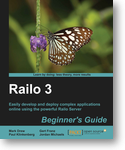I am a regular Railo user and use it everyday. I absolutely love the product and CFML in general. So, when this book came out, my first reaction was to ask Packt Publishing for a review copy, which they happily gave to me.
I have spent a few hours reading the book already and my first impression is that the book pretty much does justice to it’s title. The book is a beginners’ guide and it starts from the very basics of what is Railo, how to install it on different OS’s, how to write your very first basic CF code and slowly, as the chapters go along, the book does get into depths of how to write your own apps, and how to extend the Railo server by writing your own tags and extensions. The overall journey the book takes you over should be enough to get you excited and get started with Railo – which is what the intention of the authors is 🙂
The book has been written by some of the very well known people in the CF world. Mark Drew, Gert Franz, Jordan Michaels, Paul Klinkenberg are the authors of this book and anyone who has spent any amount of time in CF development must have come across theses names at some point, anyways.
Railo Server is one of the quickest ways to start developing complex web applications. Widely considered as the fastest CFML (ColdFusion Markup Language) engine, Railo Server allows you to create dynamic web pages that can change depending on the user input, database lookups, or even the time of day.
What this book covers
- Chapter 1 – Introducing Railo Server, gives an introduction to Railo Server and also shows us an overview of how it is a breeze to develop web applications.
- Chapter 2 – Installing Railo Server, describes how to install Railo Server under a number of operating systems as well as using different servlet containers.
- Chapter 3 – CFML Language, provides a foundation for using the CFML Language to develop sites in Railo Server. This chapter also covers object-oriented programming with components as well as functions and tags.
- Chapter 4 – Railo Server Administration, details the functionality in the server and web context. It also explains how different settings affect the behavior of the server and cover a number of other topics, such as Extension , Archives and Resources, and Security.
- Chapter 5 – Developing Applications with Railo Server, looks at how applications can be defined programmatically, the Application.cfc lifecycle, and also how components interact with the database and even looks into various caching techniques.
- Chapter 6 – Advanced CFML Functionality, looks at the scripting formats available in CFML, while investigating the CFScript language. It also looks at the built-in components available in Railo Server.
- Chapter 7 – Multimedia and AJAX, this practical chapter goes through converting and displaying video, as well as communicating between the browser and the server using the AJAX functionality of Railo Server.
- Chapter 8 – Resources and Mappings, describes how to use local and remote resources via the use of mappings within Railo Server. It also looks at how we can use ZIP and TAR files, using RAM as a handy resource and saving our files out in the Cloud using Amazon S3.
- Chapter 9 – Extending Railo Server, looks at how we can create new tags and functions for Railo Server and create an extension so that we can share our changes to the core server with other Railo Server users via our own Extension Provider.
- Chapter 10 – Creating a Video-sharing Application, brings together all your skills into a single application, setting up the Object Relational Model (ORM), creating security, converting your videos, and displaying your videos for everyone to use!
I would definitely recommend this book. 🙂




